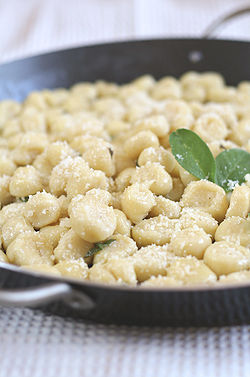
Back نوكي Arabic نوكى ARZ Ньоки Bulgarian Nyoquis Catalan Niyoki CEB Noky Czech Gnocchi Danish Nocken (Gericht) German Νιόκι Greek Nokoj EO
 | |
| Type | Dumpling |
|---|---|
| Course | Primo (Italian course) |
| Place of origin | Italy |
| Main ingredients | Potatoes, semolina, wheat flour, breadcrumbs; sometimes eggs, cheese |
| Variations | Cavatelli, gnudi, malfatti, malloreddus, strangulaprievete |
Gnocchi (/ˈn(j)ɒki/ N(Y)OK-ee,[1] US also /ˈn(j)oʊki, ˈn(j)ɔːki/ N(Y)OH-kee, N(Y)AW-;[2][3][4][5] Italian: [ˈɲɔkki]; sg.: gnocco) are a varied family of dumpling in Italian cuisine.[6] They are made of small lumps of dough, such as those composed of a simple combination of wheat flour,[7] potato,[8] egg,[9] and salt. Variations of the dish supplement the simple recipe with flavour additives, such as semolina flour,[10] cheese,[11] breadcrumbs,[12] cornmeal[13] or similar ingredients,[14][15][16] and possibly including herbs, vegetables, and other ingredients. Base ingredients may be substituted with alternatives such as sweet potatoes for potatoes or rice flour for wheat flour. Such variations are often considered to be non-traditional.[13]
Gnocchi are commonly cooked in salted boiling water and then dressed with various sauces.[13] They are usually eaten as a first course (primo) as an alternative to soups (minestre) or pasta, but they can also be served as a contorno (side dish) to some main courses.[13] Common accompaniments of gnocchi include melted butter with sage, pesto, as well as various sauces. Gnocchi may be homemade, made by specialty stores, or produced industrially and distributed refrigerated, dried, or frozen. Small soup gnocchi are sometimes made by pressing the dough through a coarse sieve or a perforated spoon.
- ^ "gnocchi". Lexico UK English Dictionary. Oxford University Press. Archived from the original on 2019-12-16.
- ^ "gnocchi". Merriam-Webster.com Dictionary. Retrieved 2 October 2019.
- ^ "gnocchi". Dictionary.com Unabridged (Online). n.d. Retrieved 2 October 2019.
- ^ "gnocchi". The American Heritage Dictionary of the English Language (5th ed.). HarperCollins. Retrieved 2 October 2019.
- ^ "gnocchi". Collins English Dictionary. HarperCollins. Archived from the original on 2 October 2019. Retrieved 2 October 2019.
- ^ Cite error: The named reference
ss42was invoked but never defined (see the help page). - ^ Buonassisi, recipe #831-833
- ^ Buonassisi, recipe #854-857
- ^ Buonassisi, recipe #837-838
- ^ Vincenzo Buonassisi, Il nuovo codice della pasta, Rizzoli 1985, recipe #850-853
- ^ Buonassisi, recipe #839-840
- ^ Buonassisi, recipe #877 "Al Pien... si tratta di gnocchi, delicatissimi, secondo un'antica ricetta mantovana..."
- ^ a b c d Riley, Gillian (2007). The Oxford Companion to Italian Food. Oxford: Oxford University Press. ISBN 978-0-19-860617-8.
- ^ Waverley Root, The Food of Italy, 1971 passim
- ^ Luigi Carnacina, Luigi Veronelli, La cucina rustica regionale (4 vol.), Rizzoli 1966, passim
- ^ Accademia Italiana della Cucina, La Cucina: The Regional Cooking of Italy, tr. Jay Hyams, Rizzoli, 2009, passim